Hello everyone, this is The Jungle blog.
I was on YouTube one day watching videos when I saw an ad that astounded me with how audacious its claims were. It was advertising ‘Responsible Bacon,’ which they claimed was good for the environment and was ‘carbon neutral.’ I knew better than to take the advertisements at face value. 99 percent of animals made into meat are raised on Factory Farms, where animals are crammed into filthy spaces too small to move. They sleep in their own urine and feces, which sits and turns into ammonia gas. The industry doesn’t have an incentive to consider more humane alternatives. To match consumer demand, they have to over-breed animals, which uses up land, plants, and water, which could be used to feed more humans. Millions of living, feeling, animals are slaughtered each year. Workers have to kill an average of 250 cows per hour. As you can imagine, all this is terrible for the environment. In fact, it’s one of the biggest contributors to the climate crisis. We have to address it.
Anyways… I was skeptical of the advertisement I saw on YouTube – and I know that companies most heavily advertise things which are the most audacious to claim.
Later, I learned about the concept of ‘carbon offsets’ which corporations use to claim that they’ve reached carbon neutrality. Then I went to the website directly and took a look at their claims. The company is called Greenfield. They’re based in Canada but for whatever reason they advertise to Americans specifically. Now let’s think about the tone of what they say their business is about. They make all sorts of claims about their farms being humane, but as you’ll see later, they still look like shitty places to live – and what their statements essentially say is, let’s murder animals in a way that’s good for the environment.
Before we dive right in, let’s take a look at the statements the company leaders have made during interviews. Here’s a slogan on their site. “The Bacon Rebate: How to help save the planet, eat bacon, and get paid.” Apparently you can ‘save the planet’ by eating carbon offset bacon, and make money. Totally not too good to be true.
Here’s another statement. “We are proud to offer consumers great tasting, sustainable bacon that they can feel good about eating,” and another, “Conscious carnivores don’t have to give up the foods they love.” That phrase is hilarious. “Conscious Carnivores” That’s like saying “Loving flesh-eaters.” Also, don’t it twisted. People who eat meat aren’t carnivores. They eat plants too. That makes them omnivores. Any homo sapien that attempts to be a carnivore is going to get constipation. Here’s another statement: “The Bacon Rebate is part of a larger campaign aimed at helping Americans ‘have their meat and eat it too,’” Again, this company is based in Canada, but funnily enough they advertise to Americans specifically. It’s like Greenfield thinks Americans are stupid or something. Also, the saying ‘You can’t have your cake and eat it too,’ would be better if it were, ‘You can’t eat your cake and have it in your hand afterwards,’ but unfortunately that doesn’t roll off the tongue. One final statement, “… we see an opportunity to help conscious carnivores feel good about their choice…”
So if you go to their website, you’ll notice they talk exclusively about pigs. The pictures are all of pigs. Why? As you’ll see, pigs are the easiest animals to make exaggerated claims about. They make the following statements: “Temperature and ventilation settings are carefully set to match the requirements of each growth stage. Barn environments are monitored daily to ensure acceptable conditions are maintained… Alarm systems protect the barn from sudden changes that could result from power outages or equipment failure. If these events occur, backup generators maintain a constant environment for the animals.” Temperature and ventilation settings being set to match the requirements of each growth stage isn’t special. All Factory Farms have to do this for pigs specifically. Pigs have a harder time regulating their body temperature compared to other animals. If farms didn’t control the temperature to some degree the pigs would drop dead, which would interfere with meat production. This doesn’t mean their living quarters are comfortable. Also note that they’re referring to growth stages. This isn’t a matter of humanitarianism. This is a matter of maximizing profitability on animal corpses.
As for the buildings having alarm systems which go off during power outages – of course they do. If the buildings didn’t have minimal controls, the pigs would drop dead. You’d have a pile of downed pigs, which would result in gross, unusable meat.
The next claim made is that the pigs’ living quarters “…are thoroughly washed, disinfected and dried between each batch of pigs so that every new group of animals has a warm dry environment when they enter the barn.” So why do they have to claim that living quarters are washed, disinfected, and dried? Well – factory farms have so many animals crammed together, and they sleep in large piles of their own urine and feces. Ammonia gas forms which burns the animals lungs and eyes. Workers have to wear special masks. Pigs are the only animal where some attempt is made to pump the feces out of their cages. This isn’t done out of love for the animals. This is because pigs produce SO much of it. Over a hundred million tons each year. I don’t know how exaggerated Greenfield’s claims are – but what I just described would be the one modicum of truth here. Also, even if the feces are cleaned between ‘each batch of pigs,’ why is this amount of feces being allowed to accumulate in the first place? Surely if a pig was living in a nice grassy field, or was someone’s pet there’d be a better solution for separating living and bathroom space. Try to think of it in these terms the next time you evaluate whether living conditions are ‘humane’ or if an animal is experiencing suffering. Also, why are the living quarters just cleaned when there is a new batch of pigs? Isn’t there a way to clean them within the same batch of pigs? Is there no place to move them, or is this just not profitable? What happens to a batch of pigs when they are replaced?
Secondly, millions of tons of feces have to go somewhere after they’re cleaned. They can’t just lie around, they have to be disposed of. Typically, untreated hog waste is dumped into the water supply of nearby minority neighborhoods – where these types of farms are typically built.
Before talking about their claims about living spaces, let’s look at the statements Greenfield makes about their breeding sows to get a better picture. These are female pigs used to make babies. They call their program, Advanced Open Sow Housing.
Their website says the following. They spend 7-9 days in breeding crates. Zero days in gestation crates, and 21 days in farrowing crates.

On their website they brag about getting rid of gestation crates, more commonly known as ‘sow stalls.’ This isn’t that special. Sow stalls are where pigs are kept during pregnancy. They’re crammed in a small space and forced to lie on the hard floor. These stalls are actually bad enough that two states in America have banned them – a country not known for its wide array of animal welfare laws. The two states that have banned them are Florida and Arizona.
But the pigs still spend 7-9 days in breeding crates. Pigs are forcibly bred. Terrified sows are typically tied to what the industry nicknames ‘rape tables.’ And the animals still are spending 21 days in farrowing crates, where a mother is crammed into a small space with her children.
The following statement is made: “…a sow: Is free to explore their surroundings and have social interactions with each other and their caregivers.” Their caregivers, as in workers hired to move them. But they are still breeding sows. Breeding sows are kept perpetually pregnant. After she gives birth and is given the most minimal time to nurse, she is impregnated as soon as its physically possible. A breeding sow is made pregnant again and again until her body can’t take it anymore, and then she’s killed.
The Greenfield website makes the following claim. They say that the breeding sows have ‘improved wellbeing, leg, and joint health.’ However, the reason breeding sows have leg and joint problems in the first place is because they have to lay on the hard floor while pregnant.
Here’s a statement made about their pigs in general. Not just the breeding sows. “All of our pigs are raised in open pens where they can freely move around, sleep and socialize with other animals.” Obviously with the ‘open pens,’ they’re partially referring to getting rid of sow stalls.’ But pens can still be cramped, discomforting, and dirty. You could still be crammed with a thousand other animals. With all the wonderfulness of a warehouse, with its hard floors, and metal beamed roofs. Claims of open pens with free movement and socialization have always been shaky at best. When photos are provided they still don’t look good, and companies are typically trying to figure out what photos look the best, and they get to decide when they take the photos. Farms don’t usually look the same when a whistleblower applies for a job and takes photos of the work environment. When evaluating claims like this, keep the following in mind: What does and doesn’t qualify as a free range farm is poorly regulated. If an animal goes outside even once in their life, it can qualify as a free range farm, even if the animal spends the rest of their life in a cage, lives in horrible conditions, or goes through rushed painful slaughter. For example the practice of separating male and female chickens at birth, and immediately killing newborn males is still commonplace on ‘free range’ farms. On such farms, animals live even shorter lives because it’s more profitable to have it be so; and most animals are only allowed to live for a year or two in the first place.
Before we go on… they show the environment the sows live in on their website. They have an interactive video which I took at. I took a couple of screenshots here, and I think you should see them.
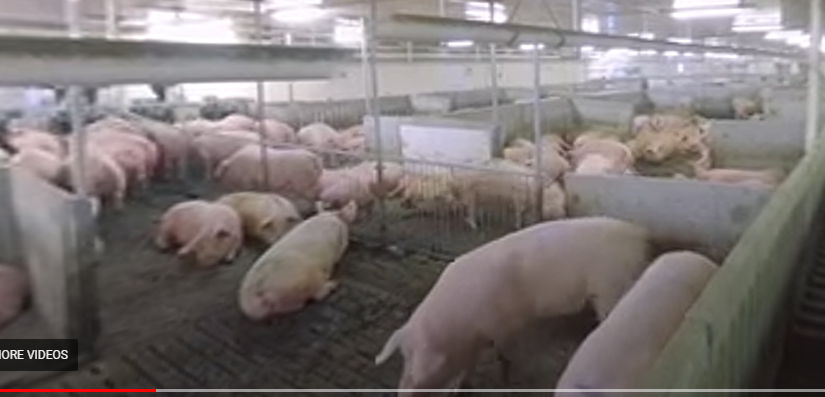
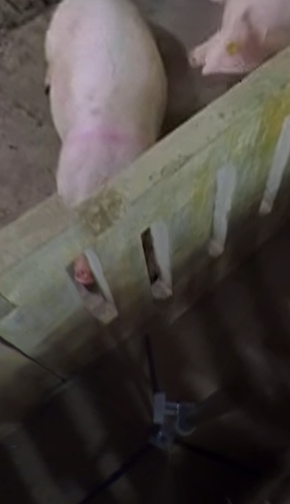
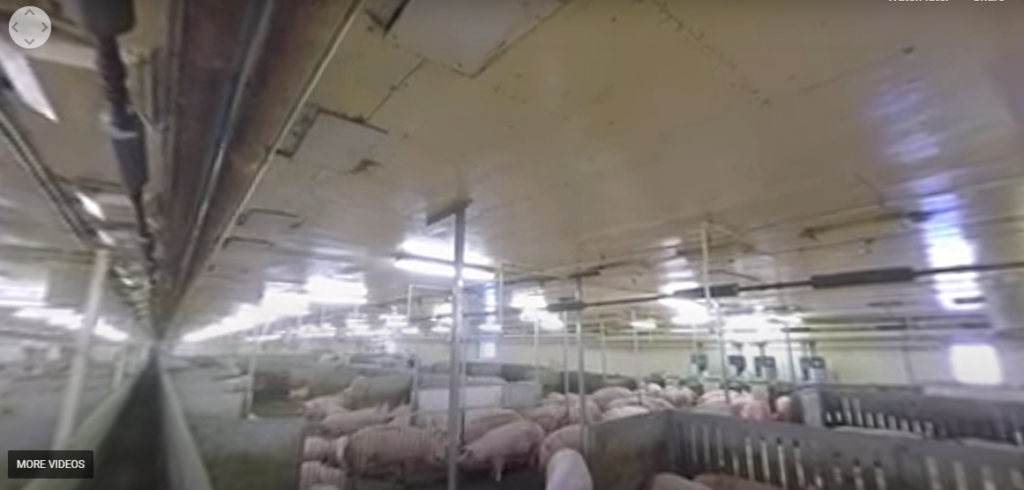
Wow… look at that awesome environment. The dingy gray room. Inside of a warehouse. There’s the awesome hard floor, and the wonderful metal beams on the roof. And there’s so many pigs, how clever. Instead of having the mothers and children living together in their natural social groups, just breed as many as possible and put ‘em in a building. What a wonderful place to live. This looks so humane.
But to be serious for a moment… this company does get to decide when they start filming their videos. An important question to ask is how many pigs do they usually keep in this environment when they’re not recording. It’s very likely that the amount of workers and livestock in this room was modified before this video was shot. They’re trying to ‘put their best foot forward’ and even then, this looks like a shitty place to live.
The next statement about the breeding sows says that ‘…a sow… is fed through electronic sow feeding system that ensures optimal nutrition for each individual animal and reduces aggression among group-housed sows.’ The reduced aggression is something that gets brought up multiple times. In another list of claims, they say, “We maintain stable animal groups to support natural behaviour, socializing and to minimize aggression.” Take note of the language in this statement. They say, ‘Stable animal groups.’ It indicates a view of them as property. They say, ‘minimize aggression.’ Pigs are naturally friendly, sociable animals. Think of the potbelly pigs people keep as pets, they snuggle, learn tricks, etc. But on factory farms, pigs cannibalize their children. They bite each other, becoming crazed by the taste of blood. Therefore, pieces of their teeth and tails are removed without painkillers to prevent bite marks from appearing on their corpses. This aggression is highly unnatural. It only happens because the animals become crazed from stressful conditions – and it’s not just pigs either. You see increased aggression and cannibalism with chickens and turkeys too. So my question is, why are they talking about ‘minimizing aggression’ here? Imagine if we said this about a group of dogs living in clusters at a warehouse. We promote ‘stable animal groups.’ We ‘minimize aggression.’
I want to take a look at a statement made about breeding sows. It says that ‘…sows… Spends only 20% of their reproductive lifetime in confinement; only during the breeding and nursing stages for the safety of the animals and caregivers.’
So they spend one fifth of their ‘reproductive lifetime’ in confinement. Only ‘during breeding and nursing stages for the safety of animals and workers.’ Except a breeding sow spends her whole life reproducing, and what about the phrase, her ‘reproductive lifetime,’ what the hell does that even mean? Saying, her reproductive years, or reproductive period would make sense. But ‘reproductive lifetime’ doesn’t mean anything. I can’t think of a better example of injustices being allowed to continue because of cleverly phrased Middle Class politeness-culture.
Also, she’s kept in confinement ‘during breeding and nursing stages for the safety of animals and workers.’ Why? Can she not nurse her child without being in confinement? Of course – they have to keep her in confinement during the forcible breeding process to make things easier on the workers. They’re probably scared of her ‘reduced aggression.’
Let’s talk about their claims on antibiotics. On their website they say they don’t use antibiotics for their animals. If an animal actually requires antibiotics and there are no other options, they are removed from the program and aren’t used for the meat supply.
This is something that needs to become common in The United States. This company is in Canada but they advertise to Americans. Overuse of antibiotics leaves residue of drugs in meat, and leads to AMR, or Antimicrobial Resistance. This kills people. These drugs are given to animals who are merely deemed ill, without checking if they actually require it. This is like when people take antibiotics for colds, even though colds are caused by viruses, not bacteria.
My question here is, why are the animals becoming sick enough to require antibiotics? Their website frames things the following way: “Despite all the measures in place to prevent illness amongst our animals, they can still get sick.”
So, it’s possible for non-captive animals and animals who live in houses to occasionally get an infection which requires antibiotics. But it’s not super common. (These animals are neither, by the way, they’re farm animals.) However the chance of a disease being transferred from a herd animal to a human is like winning a terrible lottery. The chances are astronomical. The animals aren’t the ones who are dirty. We have to do something to drastically increase the chances of infections. Like the bustling meat markets of medieval Europe, or the warehouses and pens we cram thousands of animals into today. When evaluating their statements – remember that they’re trying to frame their response to animal illnesses in the best possible light.
The next thing I want to talk about are the claims which drew my attention to this company in the first place. The idea that a farm, which breeds animals and turns them to meat is somehow saving the environment – and their claims of carbon neutrality.
They say that they eliminate all the carbon emissions they can. What nonsense. However, they say for the carbon they can’t eliminate, they use carbon offsets, and that they are carbon neutral. Carbon offsets are the concept that if you release carbon into the atmosphere, that you can just pay some money – perhaps to an environmental organization to offset the carbon you just released. This reminds me of the ‘indulgences’ given out by The Catholic Church in The Middle Ages. Anyways – if it sounds too good to be true, that’s because it is.
What counts as a Carbon Offset, and the prices you pay for them can vary wildly. For example, there are airports that can let you offset your plane ride for two dollars. Claims about offsets are often misleading or shaky at best. Let me explain what I mean.
Something that would be important for a good offset is ADDITIONALITY. For example, planting trees that wouldn’t otherwise be planted, or replacing an oil rig with a wind-farm that wouldn’t have otherwise been built. You could also prevent trees from getting chopped down, that were going to be destroyed no matter what. However, companies often pay money to already existing nature preserves that have trees that weren’t going to get chopped down, and then can use that to make big claims. Companies have even donated money to things that aren’t real nature preserves, like outdoor hunting clubs for rich men. Sometimes – companies might fund something that isn’t bad, like a charity to save whales – but that doesn’t offset any carbon. It’s not what the company advertised or promised. There have been cases of governments in developing nations forcing people off their land to provide space for nature preserves used for carbon offsets – and then the people involved aren’t allowed to talk about it. These programs continue until someone blows the whistle, and the outside countries funding it shut it down out of embarrassment.
Even without these problems, there is a deeper issue. There isn’t enough space on Earth to plant the number of trees needed to offset the carbon we put in the atmosphere. Planting trees is part of the solution. But just having companies try to claim they’re all carbon neutral is a cop out. It’s unpleasant to hear, but not destroying the planet will require sacrifice. This involves demonstrating better ways to do things as individuals, using public transport, protesting, passing regulations on corporations, using windmills instead of oil, not overbreeding animals for consumption, etc.
This company lists a bunch of examples of their carbon offsets. For example, they list a lot of wind farms they give money to.
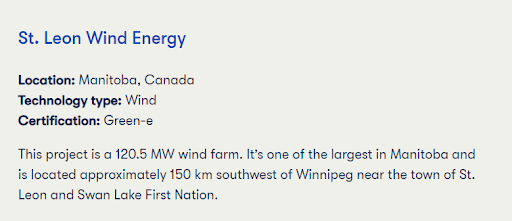
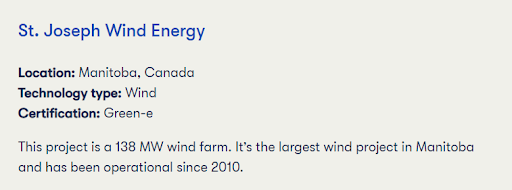
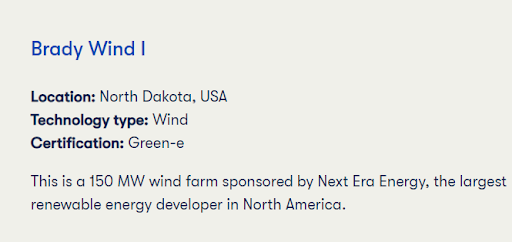
Giving money to an already existing wind farm doesn’t offset your carbon. These non-polluting sources of electricity already exist. It doesn’t provide additionality. It’s not what they promised – which is to offset their carbon. If you built a new wind farm, this would provide additionality.
That aside, I want to hone in on a specific project for a second.
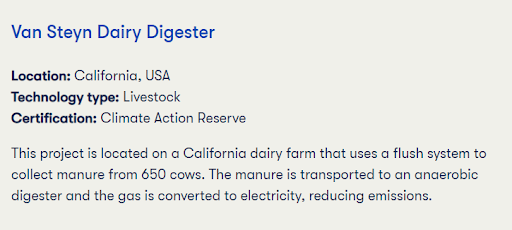
If you are a farming organization in Canada trying to offset your carbon emissions, and you pay a dairy farm in California to try to get rid of its own emissions, you aren’t offsetting your emissions. You’re offsetting theirs. Animal Farms are horrible for the environment. Both of these farms are polluting immensely, and paying someone else for a project that already exists once again doesn’t add any additionality.
There is supposed to be an intermediary group between the company trying to offset its carbon, and the organization receiving payment, in order to verify the validity of a claim. These are called Carbon Registries. However, Carbon Registries are not actually very reliable. There aren’t any good checks in place to ensure they make good decisions. Even the talk show host John Oliver was able to make his own Carbon Registry. He has a video that goes into a lot more detail about the problems with Carbon Offsets than I can. Here is the link to that:
https://www.youtube.com/watch?v=6p8zAbFKpW0&ab_channel=LastWeekTonight
For Greenfield, the Carbon Registry they work with is a group called Green Circle. Let’s take a look at some of the companies Green Circle has worked with.
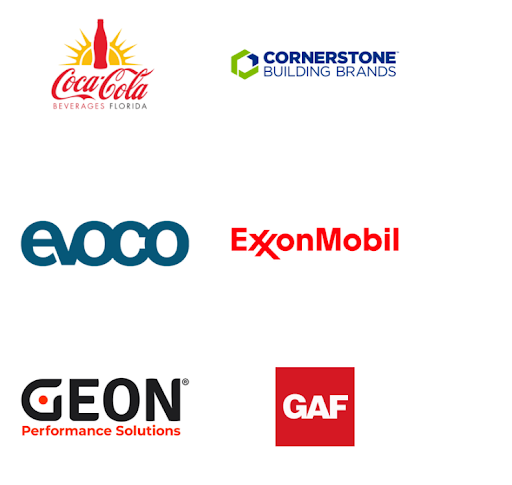
Oh wow, is that Coca Cola and Exxonmobil? Those are two companies that are totally known for being green and good for the environment. Did they manage to reach carbon zero too? That’s amazing.
Anyways moving on:
I have a few questions for the Greenfield company. Details about things that they left out of their advertising. I think that these questions are perfectly reasonable and fair if you are claiming your farms are humane.
For example, what does the slaughter process entail? See usually on farms, the average worker has to kill hundreds of animals every hour. The animals are hung upside down, and they’re required to be stunned before slaughter, but because there is a huge rush, they are often not knocked out properly. Then, the struggling animals have their throats cut, except for when the blades miss, in which case live animals like pigs, chickens, and turkeys are dunked in a scalding tank. So how is Greenfield’s slaughter process any different? Who knows. Maybe the company is a little less brutal because they’re in Canada. However, for those tempted to think conditions are better in their country because they live outside of The United States, conditions are far closer to America than you would like to think. Unless you’re a country like Sweden, you don’t even have that little bit of room for complacency.
Second question, do you use painkillers for operations and surgical procedures? Do you remove pieces of the animal’s tails, teeth, and ears? Do you participate in tail docking? During these body part removals, do you use painkillers? (These procedures are done to prevent bite marks from appearing on the animals bodies. But this heightened aggression is unnatural and comes from extremely stressful conditions. This isn’t done out of love for the animals, but because a carcass with bite marks sells for less money.)
Third, male animals are considered less efficient because they cannot get pregnant. Artificial Insemination is used on females. So how long are males kept alive compared to females? At what age are the males castrated to prevent meat taint? What is the mortality rate of newborn piglets before the fattening process?
Fourth, when castrating animals, which method do you use? Do you cut open the scrotum and tear the cord between the testicles, or do you tie a rubber band around the animal’s scrotum and wait a couple weeks for them to rot and fall off – and do you use painkillers during these surgeries?
The last thing I want to address today is this. Greenfield talks about how many Animal Welfare groups use The Five Freedoms for Animals. These are Freedom from Hunger and Thirst; Freedom from Discomfort; Freedom from Pain, Injury, or Disease; Freedom to Express Normal Behavior; and Freedom from Fear and Distress. However, Greenfield says, no – no, we go beyond that. We use the Five Domains. These are Nutrition, Environment, Health, Behavior, and Mental Domain.
This is a real problem I’ve got with Humane Washing. Proposals like these are too vague to address any specific legal, or systemic injustices that animals face. The so-called ‘sweeping reforms’ that I would propose would still technically be compromises; in other words, basic emergency measures to help relieve severe amounts of pain. But half-measures – like a few extra inches of cage space will not do. Not only will these effectively kill momentum for the Animal Movement, they will also go unenforced. People who are less involved will say ‘I guess we did something,’ and then go do something else. We need sweeping reforms. Anesthesia during any painful operation needs to be mandatory. Some of these operations shouldn’t be happening in the first place – like ear tagging, dehorning, cutting out pieces of flesh, or branding – all of which is done so farmers can mark their property. We need to outlaw veal crates and battery cages. We need to ban force feeding, and support legislation to protect downed animals. We need to outlaw intensive confinement for animals. None of the shit Greenfield has done counts by the way. Not using antibiotics on animals unnecessarily needs to be law – and animals shouldn’t be living in conditions that cause them to become so sick in the first place. To get more funding, and better enforcement for reforms, this needs to become a political issue. For this to happen we need to draw as much attention to it as possible.
Anyways, that’s all for now. If you enjoyed this article, consider checking out some other posts. Have a good day everyone.
